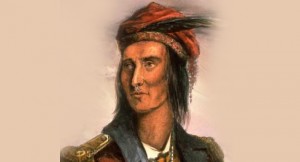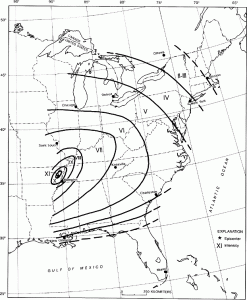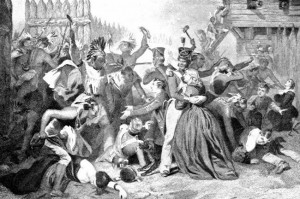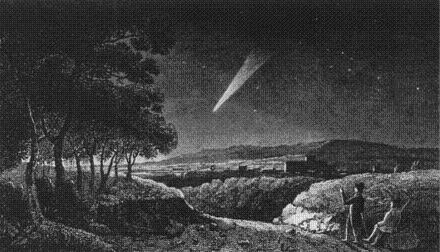The Red Stick Creeks and the Great Earthquakes of 1811 and 1812
July 16, 2014 in Native American History
Without exception every historical event has a backstory and several other backstories within it. That’s certainly true with many of the Native American stories that often fail to get told from their perspective. This is the story of the Red Creek Red Stick tribe decision making process when they joined in the War of 1812 and the role certain natural phenomena that played a backstory in their history.
Hidden Backstory
On the eve of the War of 1812, white settlers were increasingly encroaching upon Native American lands as they cut and cleared trees and built villages. Capitalizing on the deep resentment many tribes felt in regards to this, the British had already given Shawnee leader, Chief Tecumseh, guns and ammo to fight the Americans in an effort to get the various tribes to join on their side. Tecumseh and his brother Prophet Tenskawatawa went a step further and traveled from tribe to tribe trying to unite all Indians into a confederation to fight against the white settlers.
There were sixteen main tribes of native peoples that would become involved in one form or another as the conflict escalated into war. The main tribes were: Ojiibwa (Chippewa), Ottawas, Sioux (Santee Sioux), Menominee, Winnebago, Shawnee, Potawatomi, Creeks (Muscogee Creeks, Red Sticks, White Sticks), Seminoles, Choctaw, Cherokee, Chickasaw, Salk (Osakawak) and the Fox (Meskawakie). Not all of these tribes wanted war. Some pushed for peace, such as Chickasaws and the White Sticks. However, the Red Sticks for example, wanted to fight the white settlers. Soon native peoples were also fighting each other; Choctaw Chief Pushmataha led his people against the Red Sticks; the Cherokee and White Sticks joined with the white settlers; and the whole situation spiraled into one big messy war.
Prophecies About Earthquakes and Comets
It’s claimed that in 1811, as Chief Tecumseh and his brother contacted other tribes in their efforts to raise a mighty defensive army to do battle against the white settlers trying to take their land, that Tecumseh told the Red Stick Creeks in particular:
“Brothers, the Great Spirit is angry with our enemies. He speaks in thunder, and the earth swallows up villages, and drinks up the Mississippi. The great waters cover the lowlands. Their corn cannot grow. The Great Spirit will sweep those who escape to the hills from the earth with his terrible breath.”
“Your blood is white! You do not believe the Great Spirit has sent me. You shall know. I leave Tuckabatchee directly, and shall go straight to Detroit. When I arrive there, I will stamp on the ground with my foot and shake down every house in Tuckabatchee.”
The tribal location of Tuckabatchee was on the Tallapossa River in what is today Alabama. His audience were the Creek leaders, and his message didn’t go over well at the time. The leader of the Upper Creeks (Red Sticks) was Big Warrior, and he refused to pledge his people into the confederation of native peoples Tecumseh was assembling. It was Big Warrior that he accused of having white blood.
Imagine his skeptical audience’s surprise when on December 16, 1811, exactly when he arrived in Detroit, that the first of two a strong earthquakes shook the ground. Actually, these two earthquakes that hit the same day were so intense, that they are still considered the most powerful earthquakes to hit the Eastern United States in history. It’s believed the first quake hit at 2:15 a.m. at an estimated strength of 7.2 to 8.1. Six hours later a second quake of equal force hit the same area again. These were no ordinary earthquakes. The epicenter was around what is today New Madrid, Missouri. They were thought to be felt strongly across 130,000 square miles and moderately for a total of nearly 3 million miles. The earthquakes were felt as far away as the White House, and it’s said that church bells in Boston rang on their own. These earthquakes actually altered the landscape so severely, that the Mississippi River momentarily reversed its direction. It is also believed that over two thousand aftershocks occurred in the months following, five of which were 8.0 or greater in strength.
Of course, the Red Sticks thought that this was Tecumseh’s signal to start war. How could they think otherwise? Such were the calls to action that were based on prophetic insight when the events predicted came true. His prophecy was a signal to the Red Sticks and other tribes to unite in resisting the European white intruders intent on claiming their lands.
Native People and Prophecy
It is well known among Native American tribes that the wisdom of ages is passed down from generation to generation. I don’t think that any of us can definitely prove that there isn’t an ancient science for predicting the future from collective memory of the distant past that was handed down from generations ago. One can only speculate that Tecumseh knew which natural signs to look for, and there were plenty of natural occurrences during this time period for Tecumseh to draw from. Native peoples heavily relied upon stories to explain the natural world and its phenomena. Had he been taught from childhood what to look for? Or had there been a large number of mild or moderate tremors in the region that tipped him off?
Also, it’s no secret that animals and insects do seem to be able to sense such events. It has scientifically been recorded that catfish behave strangely right before earthquakes. Chickens have been known to stop laying eggs. Dogs and cats bark and whine for no apparent reason and other animals show signs of stress before such events. Are they just simply feeling the “foreshocks” that predict an earthquake? Could it be that since native peoples are more in tune with nature that Tecumseh was more in tune with what happening in a world that white people did not understand when it came to earthquakes?
The Great Comet of 1812
How much of an influence of Tecumseh’s prophecy had to do with other unusual phenomena of the time remains unknown. The Great Comet of 1812 (which was seen for over 260 nights) was so large that it has been estimated to have been over a million miles across, almost fifty percent larger than our own sun. Since the comet was becoming more visible during the New Madrid earthquakes in December of 1811, arriving almost in conjunction with a fiery comet rushing across the horizon, it must have also struck fear into many native peoples hearts. After all, wasn’t the comet all part of Chief Tecumseh’s prophetic prediction of a great fire coming across the sky?
Here too, the ability to predict the future was a part of many Native American tribes, and the Shawnee culture and religion did acknowledge that many of the leaders and medicine men of such tribes could predict the future based on their extensive traditional lore. Shawnee cosmology dictated that catastrophic things happen when people do not follow the warnings and laws of their given Deities. Certainly the sanctity of ancestral lands and the obligation to protect them from invaders were in fact, simply common sense to a certain degree.
Muskogee Creeks (Red Sticks) shared very similar belief systems and alliances with the Shawnee. Both were among the “Five Civilized Tribes.” When it came to the Red Stick Creeks and the others who joined in the Native American confederation in the War of 1812, it really didn’t matter whether or not Chief Tecumseh and his Prophet brother could actually predict the future — all that was important was that they believed he had been right. The Great Spirits did indeed seem angry. Belief in something is sometimes all the power a leader needs to motivate his soldiers in action.
Surprisingly, Tecumseh, although angered when they first refused to join in, needed them as much as they needed his guidance. The Red Sticks had a long history of being fierce warriors who trained since birth for war. When Tecumseh lost his life shortly after, the decisions made by those Native American leaders who remained in the war spelled the beginning of the end for America’s native peoples and their way of life. It also would prove to be the complete loss all their native lands to the invading white settlers and rulers.




Recent Comments